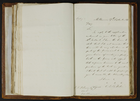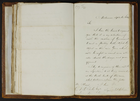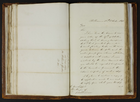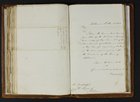Multimedia Content

Copy of letter from Charles La Trobe to J Palmer, Esq, 27 September 1843, courtesy of Public Record Office Victoria, Victorian Archives Centre.
Details
Letter from Charles La Trobe to Mayor, 26 September 1843, courtesy of Public Record Office Victoria, Victorian Archives Centre.
Details
Letter from Charles La Trobe to Mayor, 30 October 1843, courtesy of Public Record Office Victoria, Victorian Archives Centre.
Details
Letter from Charles La Trobe to Mayor, 4 March 1844, courtesy of Public Record Office Victoria, Victorian Archives Centre.
Details
Baths and Bathing
Bathing has enjoyed great popularity in a city whose summer climate has always seen Melburnians seeking relief at all hours of the day or night at pools and beaches. In Helen Garner's Monkey grip (Melbourne 1977), the characters lounge on the burning concrete at the Fitzroy pool, fooling around in the deep end by the 'Aqua Profonda' sign. Long days at the pool or school swimming classes are a feature of many childhood memories, and over 100 suburban swimming pools now provide summer sanctuary for tens of thousands.
The Yarra River was an early natural site for bathing, and throughout the 1840s and early 1850s, entrepreneurs attempted with varying degrees of success to establish floating baths on the town's principal waterway. As early as 1844, city by-laws had prohibited daytime bathing within the town boundary in view of any public areas, though the law was commonly flouted.
Late in the 1840s, N.L. Kentish announced a scheme to establish his Victoria Baths, to be situated on the Yarra River just west of the Yarra Falls. Prizes were advertised to promote 'the invaluable art of swimming', but the proposal was never realised. Kentish had drawn inspiration from the old adage 'cleanliness is next to godliness'. This association between physical and moral purity was being pursued by reformers in London and New York, where the Bath and Wash-House movements saw the establishment of public baths for the labouring poor by the end of the 1840s. A Bath and Wash-House Co. was formed in Melbourne in 1853, and the opening of the Royal Melbourne Baths was welcomed by the Argus as promoting comfort, cleanliness and decency.
In 1856 Thomas E. Rawlinson recommended the establishment of public baths as a 'habit and necessity' for the working classes as an alternative to the corrupting influences of hotels. Dr Thomas Embling, MLA for Collingwood, was the driving force behind a Public Baths Select Committee, and following the start of the Yan Yean water supply in 1858, the Melbourne City Council opened the first Melbourne City Baths in 1860. Jobson's Handbook for bathers (Melbourne c. 1866) extolled the virtues to health of mind and body of swimming and of a range of bathing practices. In the 1870s leading public figures testified to the medical, cleansing and luxurious attributes of J.S. Hosie's Turkish Bathing Palace in Bourke Street.
An alternative to private or public baths was a trip to the bayside suburbs. Liardet's Pier Hotel at present-day Port Melbourne had advertised swimming baths in 1842, and in 1844 T.M. Crosbie boasted a bathing machine at the Brighton Hotel. In 1853 Captain William Kenney took over Mary Ford's sea-bathing venture at St Kilda, and railways soon brought the beach within easy reach. Baths were established at Sandridge in 1858, and Kenney opened the Brighton Beach Baths in 1863. The Middle Brighton Baths were built in 1881, and later in the century bay steamers took Melburnians for day trips or trade picnics to the sea baths at Mornington.
Corporation baths were constructed at Middle Brighton in 1881 and rebuilt in 1936 after being destroyed by a storm two years earlier. A reconstructed sea enclosure was opened in 1986, and they remain one of Australia's few surviving beach baths.
Private bathrooms were a comparative rarity until the end of the 19th century, and by the 1930s only half of the houses in some suburbs had baths. While fears of disease added to the necessity for public bathing facilities, the lack of adequate filtration and disinfecting at public pools themselves was often less than hygienic. Suburban baths opened at Richmond (1897), Fitzroy (1908), North Melbourne (1910) and Brunswick (1914). Bathing was also popular in flooded quarry holes, lakes and local river and creek systems, and swimming clubs sponsored carnivals at swimming basins in the Yarra River at Fairfield Park, Alphington Park and Deep Rock.
It was common for men to swim naked at suburban pools until the 1920s. While public baths were originally divided into first and second-class facilities, municipal regulations had also segregated bayside beaches along gender lines. Until the 1910s open sea-bathing was discouraged during daylight hours, and it was not until 1917 that mixed bathing was introduced at St Kilda. The Melbourne City Baths opened to mixed bathing at all hours in 1947.
As the function of public baths turned from hygiene to recreation, they became the sites of summer carnivals, life-saving demonstrations and swimming races. Attempts by city commissioners to close some local pools have been resisted by resident groups, most notably at the Fitzroy Pool in 1994. By the late 20th century many local pools had become leisure and community centres, boasting a range of sporting facilities, spas, cafés, gymnasiums and meeting rooms.
